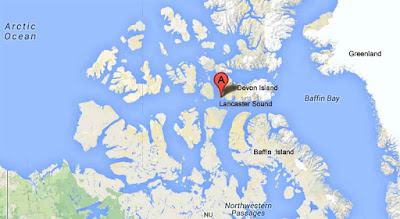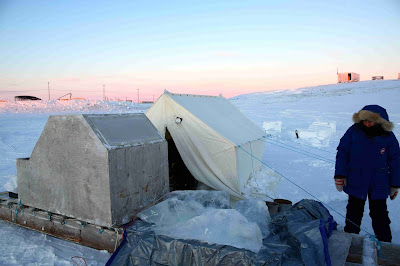 |
| The younger kids are bussed to school, the older students all walk. |
No matter where you travel in the
world, it's all about the kids. They make you smile, they make you
laugh...and sometimes they make you cry. Nunavut Territory in Canada
is the same.
While I've only been to two communities
(so far) both have been similar but different. Apart from climate, a
common element in both was the kids. You would think that in January,
February and March, people would stay inside.
 |
| The extra knee protection for crawling in the snow |
Especially, if the the temperatures
were in the minus twenty Celsius range AND if there was only a few
hours of daylight. That wasn't the case in Rankin Inlet last
winter...and it's certainly not the case here in Cambridge Bay
either. As my time here comes down to the last few days, it's been a
time for me to reflect and summarize what I learned this trip.
Nunavut, the territory, is only 17
years old. It has grown up fast. The changing landscape includes the
mining of natural resources, both open pit and deep shaft. The mining
activities continue through the cold months, of which there are many
at this latitude.
 |
| Kite boarding on the Bay |
The Inuit are concerned about these
changes as are many elsewhere. Careful management of these projects
is ongoing. One can only hope that enough precautions are enforced to
protect “this beautiful land” as one of my flag signers wrote.
Change is nothing new to the Inuit.
Early exploration brought change...the internet continues the trend.
After my xray examinations were complete, I had many opportunities to
talk with my patients and their families while they awaited further
medical treatment and attention.
 |
| Enjoying the sunny part of the day |
The same question gave many results.
“Have you lived in Cambridge bay all your life?” While many
different communities were named, some stories are detailed here. The
first involves CHIMO BAY...a hamlet in name only.
 |
| A friendly wave to the guy taking photos in town |
Firstly, two stories about Chimo Bay.
The location is 190 kilometers from here and a focus in the community
was the Hudson Bay trading post which closed in the early 70's. Those
living there simply moved to the two closest hamlets...one being
Cambridge Bay. I can't imagine being a seven year old and starting
fresh, let alone having the parents and friends bearing the brunt of
the relocation.
I asked him have you ever been back?
Not for about thirty years he sad....you could see a sadness in his
eyes as he reflected and continued...some families have kept cabins
there...I probed no further not wanting to bring further memories to
the surface.
Clarence, the Inuit carver, signs his
works CHIMO BAY as well as his name. I expect it's to honour his
ancestors and his birthplace. I may see him in town this weekend to
ask.
 |
| One of three playgrounds that I found in the hamlet |
Another person I talked to was a
“lifer” here, except for his years of high school. It's a time
when all teenagers were sent went away from their home community to
INUVIK or other “larger”centres and were raised in “residential
schools”. We have heard the horror stories of some of those. During
the discussions on the founding of this territory, for many years he
had sat on the Nunavut Implementation Commission.
 |
| Walking to school, no crossing guards but we have a pedestrian X-walk |
Another person affected by”going
away” to high school was a young lady from Ulukhoktuk, Northwest
Territories, who came to Cambridge Bay to attend high school. She's
been here ever since. Originally, she left her home on the other side
of Victoria Island and arrived here still on Victoria Island. While
she was here, a new high school in Cambridge Bay came to life but she
never attended as it opened the September after she had graduated a
few months earlier.
 |
| Hockey and Basketball are 2 of the indoor sports |
While in school, the Territory of
Nunavut became a reality so she automatically became a Nunavut
resident as the new border crossed our island. She has family still
there, but has never been back. A common story of past present and
future.
I went to the arena, last sunday night,
climbed the steep steps up to the top row of seating to get a good
view of the ice. I met Stephen and his daughter watching a cousin
play... and was later introduced to his wife Lisa and 2 more
children. That's a typical family, here in Cambay, for many. Three of
more supported by his job as a carpenter buoyed by the housing
growth.
 |
| A family leaving after the hockey game |
 |
| Lisa and some of her "girls" |
One saturday, I met Harlem playing in
the snow climbing and sliding on the snow drifts...just having a ball
like any almost three year old. Dressed in snow pants and mitts,
boots, scarf with cheeks as red as Santa's suit. After talking to his
parents, I climbed the hill and walked over a couple of streets. In a
playground, I found kids climbing on the equipment and swinging on
the swings....it was -28C that day. They were dressed and under the
watchful eye of their mother, out walking the family dog.
And then another Saturday, I met a
family out for breakfast at the Arctic Inn. I was just finishing up
and the family at the next table drew my attention. Two women and two
young boys were having a great time...the boys appetites almost as
big as they were. The oldest boy (about 9) had just finished the same
style breakfast I had completed.
 |
| Another playground...what does the future hold? |
His younger acquaintance (brother,
cousin, friend) had a stack of toast along with a plate of 10 pieces
or more of bacon...he was relishing every mouthful. They call him the
“baconator” she laughed. Knowing the number calories burned off
in this climate and the level of physical activity that is achieved
here, I hoped he wasn't headed to the video game console at home as
the sunlight gave us about 4 hours now.
I'm heading to the rink again this
morning to see the minor hockey leagues play. The rising sun is
causing a bright orange glow along the landscape with a clear blue
sky that escapes description.
The day is dawning bright and clear.
Today's short term future is known.
But for The Kids of Cambridge Bay...the
future of NUNAVUT...will they stay or will they go?






















































